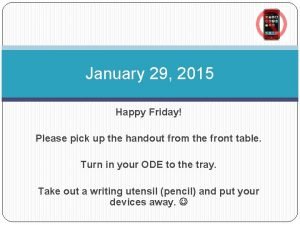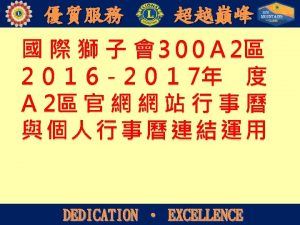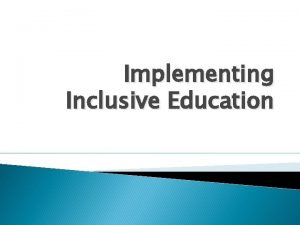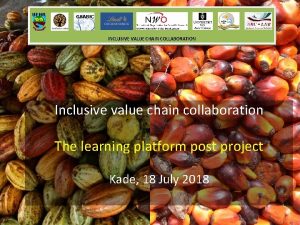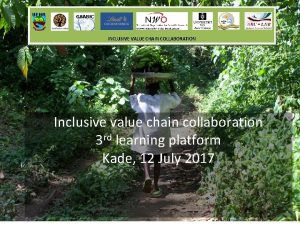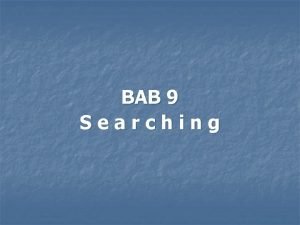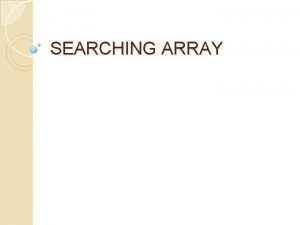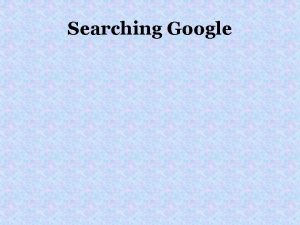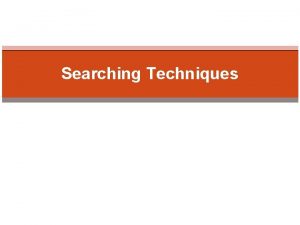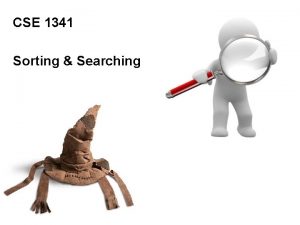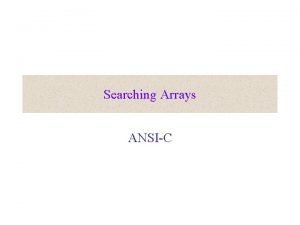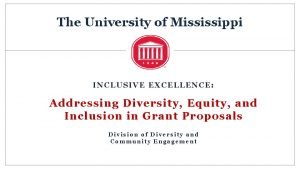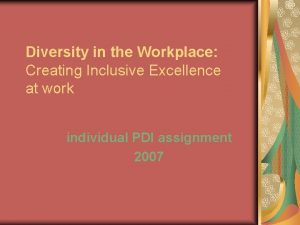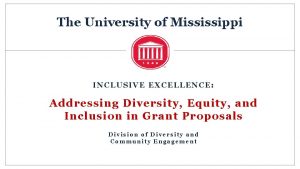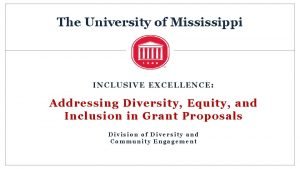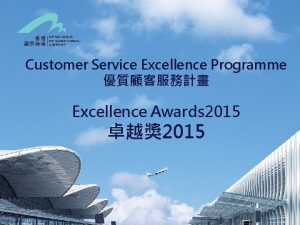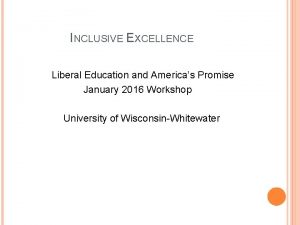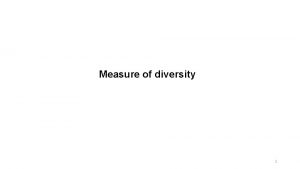Searching for Inclusive Excellence January 15 2015 Diversity






























- Slides: 30

Searching for Inclusive Excellence January 15, 2015 Diversity and Inclusion Gender Initiatives in STEMM The Women’s Place

Why Recruit for Diversity? • Complex problems need many viewpoints to achieve the best solutions • More diverse backgrounds and ideas increase the likelihood of creativity and new solutions • Increasing diversity gives us access to talent currently not represented • A diverse faculty has positive effects on our diverse student body Carrell, Page, & West (2009). National Bureau of Academic Research. (14959), 1 -42. Hale & Regev (2011). Federal Reserve Bank of San Francisco Working Paper, (2011 -19).

Inclusive Excellence Why Focus Now on the Professoriate of the Future? • Between 1998 and 2008, student enrollment increased by 32% (from 14. 5 to 19. 1 million) • ~33% of these incoming students were from underrepresented racial and ethnic groups • In 2009 -10, faculty members of color represented 18% of all full-time faculty members in degree-granting institutions • 2023 - More than half of all U. S. children will be minority. • 2042 - Minorities will be the new majority. Snyder & Dillow, 2010 Knapp, Kelly-Reid, & Ginder, 2010

Inclusive Excellence The 21 st Century Professoriate • The US Department of Education reported that in 1981, African Americans who held full-time faculty positions in higher education composed 4. 2 percent of the faculty population. • In 2003, over two decades later, this number slightly increased to 5. 6 percent. • At this rate of improvement, it will take more than 180 years for the black faculty percentage to reach parity with the black percentage for the US population. -Quoted in “Recruiting the Next Generation of the Professoriate” by Karen Jackson-Weaver, et al. in peer. Review, Summer 2010, Vol. 12, No. 3

Inclusive Excellence The 21 st Century Professoriate • Women students make up 49. 5% of students at OSU as of fall 2014. The proportion of female faculty members (tenure track, clinical and regular) is 38% and much lower at the senior ranks (25% for full professors). Women students in the STEMM disciplines have even fewer female role models on the faculty. • African American women (1. 6%), Asian American Women (4. 9%), Hispanic women (1. 4%) and other women of color (. 5%) make up a small fraction of the faculty in 2014 and growth has been minimal over the last 15 years See the Annual Status Report on Women for 2014 -15 and for 2012 at http: //womensplace. osu. edu

Diversity Excellence Inclusive Excellence Diversity

Task for Search Committees Ensure Broaden the Become Equitable aware of unconscious Pool of Consideration biases Candidates of all Candidates

Overview Six Steps: 1) Examine our own biases 2) Prime the pump (recruit before you need it) 3) Build an effective search committee 4) Define your search as broadly as possible 5) Thoughtfully evaluate candidates 6) Host an effective visit

Recruiting Diversity Research shows that we all perceive and treat people differently based on their social groups (race/ethnicity, gender, sexual orientation, disability, etc. ). We are often unconscious of our own attitudes and associations and this may affect searches We are all subject to unconscious bias. Valian (1998) Why So Slow? The Advancement of Women. Cambridge: MIT Press, p. 280.

The Unconscious Mind • When we encounter a new person: • All of the associative beliefs and stereotypes stored in our brains that connect to his or her gender, age, class and race are automatically and unconsciously triggered.

Unconscious Attitudes • Are widely culturally shared • Are applied more under circumstances of: • • Stress; competing tasks Time pressure Lack of critical mass Ambiguity & lack of information Dovidio & Gaertner (1998). In Eberhardt & Fiske (Eds. ), Confronting racism: The problem and the response (pp. 3 -32). Newbury Park: Sage. Dovidio & Gaertner (2000). Psychological Science, 11(4), 315 -319. Fiske (2002). Current Directions in Psychological Science, 11(4), 123 -128. Heilman (1980). Organizational Behavior and Human Performance(26), 386 -395. Sackett, Du. Bois, & Noe (1991). J Applied Psychology, 76(2), 263 -267. Valian (1998) Why So Slow? The Advancement of Women. Cambridge: MIT Press, p. 280.

Unconscious Attitudes Affect Evaluation and Performance • Male and female psychology professors hire “Brian” over “Karen” as an assistant professor (2: 1). • Differences in recommendations for successful medical school faculty applicants Letters for men: • Longer • More references to: • CV • Publications • Patients • Colleagues Letters for women : • Shorter • More references to personal life • More “doubt raisers”

Examine Biases 1) Examine Our Own Biases: awareness is an intervention in itself Harvard University’s Project Implicit and the Implicit Association Test: https: //implicit. harvard. edu/implicit/demo/

Unconscious Attitudes Affect Evaluation of Identical C. V. s Jamal Greg Applicants with African American- sounding names had to send 15 resumes to get a callback, compared to 10 needed by applicants with white-sounding names. White names yielded as many more callbacks as an additional eight years of experience. Bertrand & Mullainathan (2004) American Economic Review, 94 (4), 991 -1013.

Prime the pump Before the search and ongoing: 2) Prime the pump: • Network directly with young scholars • At conferences, attend the special interest sessions where diverse candidates can be found • Widen the pool from which you recruit: actively pursue candidates thriving at less well-ranked institutions

Search Committee 3) Build an Effective Search Committee • Require and reward a high level of commitment. • Be aware of unconscious bias and the challenges of evaluation • Include people openly committed to diversity and excellence. • Invite faculty from other departments to increase committee diversity.

Search Committee 3) Build an Effective Search Committee (continued) • Appoint a diversity advocate.

Search Committee 3) Build an Effective Search Committee (continued) Committee members must acknowledge that unconscious bias is always present.

Broadly Defined Search 4) Define your search as broadly as possible • The broader the job ad, the larger the pool • Emphasize interdisciplinarity and opportunities to work on broad issues • Describe the specialties you want in terms that will appeal to a broad audience.

4) Define your search as broadly as possible (continued) • Search for venues to broaden your marketing to women and other under-represented groups including newsletters, specialty groups, websites • Use proactive language in the job description

5) Thoughtfully Evaluate Candidates: • Explicitly discuss the criteria that define “excellence” in advance. Do not accept “we’ll know it when we see it” definitions. • Discuss essential job qualifications. Be sure they are explicit and agreed upon. Develop a consistent screening tool.

Candidate Evaluation Tool 5) Thoughtfully Evaluate Candidates (continued) : http: //www. umich. edu/%7 Eadvproj/Candidate. Evaluation. Tool. doc

Host an Effective Visit 6) Host an Effective Visit • Provide information well ahead of the visit regarding schedule, expectations, audience. • Ask the candidate whom s/he would like to meet. • Treat all candidates well and the same way. • Try to interview more than one female/minority candidate because of critical mass effects.

6) Host an Effective Visit (continued) • Treat all applicants as valuable scholars and educators, not representatives of a class. • Show equal interest in all candidates. • Show OSU/unit commitment to diversity; make sure all candidates meet with diverse people.

6) Host an Effective Visit (continued) • Identify a host that can set the tone for the visit and provide a good introduction at the seminar. • Consider the Q&A culture in your department. • Consider cues in the environment.

6) Host an Effective Visit (continued) • Create a packet for all candidates with information on the following: • • Dual career support Family friendly policies Faculty rules on tenure clock extension Local communities • Provide the same information to all candidates.

What Can We Do? Stick with Job-Relevant Factors • Only evaluate relevant qualifications • Do not seek or discuss information about dual career or family status • Consider the unintended consequences of personal questions. If these questions arise: • • • Answer the question Do not ask further probing questions Set up resources outside of the search committee in advance and direct candidate there

What Can We Do? Possible Innovations: Criteria Review Rather than Global Review and Team of Rivals • Discuss all candidates on one criterion at a time • Search committee divides in half. Half takes “pro” position on candidate; half takes opposing position. Discuss, switch sides & repeat.

Recruiting the Selected Candidate • After a candidate is selected, aggressive recruiting begins. • Negotiation process should convey that the goal in deciding the offer terms is to create conditions for success. • Build a culture of search excellence.

Additional Resources • Portions of today’s presentation are from University of Michigan’s STRIDE program (scroll down to faculty recruitment resources): http: //sitemaker. umich. edu/advance/stride_committee Additional Resources: • University of Wisconsin-Madison, WISELI: http: //wiseli. engr. wisc. edu/hiring. php#resources • University of Rhode Island, ADVANCE: http: //www. uri. edu/advance/recruitment. html Additional resources are available on the Discovery Themes website http: //u. osu. edu/discoverythemeshires/ These include links to the Presidential search’s packet describing the central Ohio community, links to the IAT, links to OSU HR videos on implicit bias, links to the STRIDE website and presentation. We recommend that you review these resources and discuss how you will use them with your search committee.
 January 29 2015
January 29 2015 Why is genetic diversity important
Why is genetic diversity important Ecosystem jigsaw activity
Ecosystem jigsaw activity Borra hål för knoppar
Borra hål för knoppar Bris för vuxna
Bris för vuxna Sura för anatom
Sura för anatom Smärtskolan kunskap för livet
Smärtskolan kunskap för livet Trög för kemist
Trög för kemist Argument för teckenspråk som minoritetsspråk
Argument för teckenspråk som minoritetsspråk Typiska drag för en novell
Typiska drag för en novell Delegerande ledarstil
Delegerande ledarstil Humanitr
Humanitr Rita perspektiv
Rita perspektiv Toppslätskivling dos
Toppslätskivling dos Redogör för vad psykologi är
Redogör för vad psykologi är En lathund för arbete med kontinuitetshantering
En lathund för arbete med kontinuitetshantering Mat för unga idrottare
Mat för unga idrottare Geometriska former i förskolan
Geometriska former i förskolan Bästa kameran för astrofoto
Bästa kameran för astrofoto Klassens frånvaro rim
Klassens frånvaro rim Ledarskapsteorier
Ledarskapsteorier Svenskt ramverk för digital samverkan
Svenskt ramverk för digital samverkan Vad kallas den mantel som bars av kvinnor i antikens rom
Vad kallas den mantel som bars av kvinnor i antikens rom Vilken grundregel finns det för tronföljden i sverige?
Vilken grundregel finns det för tronföljden i sverige? Bamse för de yngsta
Bamse för de yngsta Densitet vatten
Densitet vatten Ministerstyre för och nackdelar
Ministerstyre för och nackdelar Sju principer för tillitsbaserad styrning
Sju principer för tillitsbaserad styrning Vem räknas som jude
Vem räknas som jude Tack för att ni lyssnade bild
Tack för att ni lyssnade bild Nyckelkompetenser för livslångt lärande
Nyckelkompetenser för livslångt lärande
